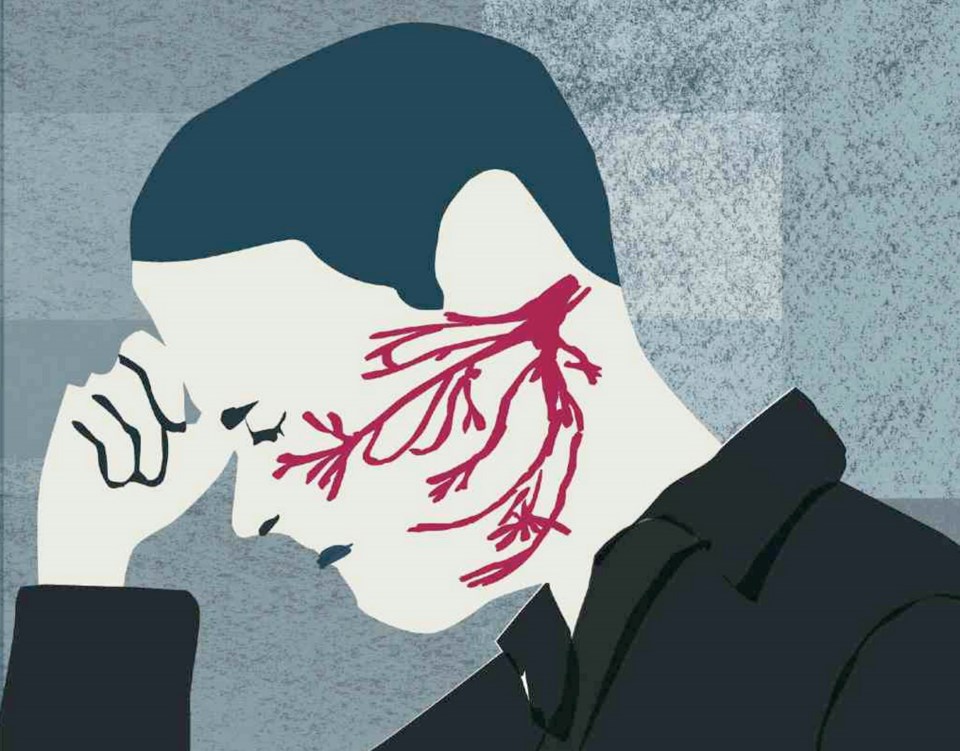Lee Shanks has many ways to describe the pain in her face erupting from the rare disorder trigeminal neuralgia, sometimes described as “suicide disease.”
On one side of her face, Shanks gets a “lightning-stroke pain over my right eye,” she said.
“On my left side, I can go anywhere from someone driving a knitting needle though my ear, to driving spikes into my teeth, to holding a burning cigarette against my eyeball, or slicing my tongue,” she said in a telephone interview from her home in Shawnigan Lake.
The 49-year-old former journalist also talks of pick-axes and hammers to the forehead, razor blades and barbed wire in the mouth and a constant burning on the face.
“I never know how it is going to manifest itself on any given day,” she said. “It’s very unpredictable.”
On Oct. 7, people around the world will be wearing teal-coloured ribbons for the first Trigeminal Neuralgia Awareness Day. Also, monuments around the world will be flashing teal.
B.C. Place will be showing teal in its Northern Lights Roof Display. In other parts of Canada, the Peace Bridge between Buffalo, N.Y., and Fort Erie, Ont., and even Niagara Falls will be lighting up with teal lights in recognition of the little-known disorder.
Trigeminal neuralgia (TN or TGN) is a nerve disorder originating with the trigeminal nerve, which is responsible for sensations in the face, and muscular movements such as chewing and biting.
Trigeminal neuralgia is also known as the most painful medical condition, which led to it sometimes being called the suicide disease.
“In the old days when there was no treatment at all, patients were faced with excruciating pain, unpredictable and often unrelenting,” said Dr. Christopher Honey, a Vancouver neurosurgeon and expert in trigeminal neuralgia.
“So there was no real hope for these people and they would often kill themselves,” said Honey, a professor of neurosurgery at the University of British Columbia.
He said the condition has been traced to the trigeminal nerve losing its outer, protective sheath. Nerves can be considered something like a transmitting electrical wire sending signals to and from the brain. And like standard electrician’s wire, nerves are also protected by an insulating cover. But instead of plastic or rubber, nerves are insulated with a substance called myelin.
Without its insulating sheath, the nerve can short-circuit, causing intense bolts of pain.
Honey said a person can imagine when a dentist inadvertently touches an exposed nerve in a tooth. That’s just one small branch of the trigeminal nerve. But with trigeminal neuralgia, the entire nerve is being touched.
“They get what they describe as a bolt of lightning that drops them to their knees,” he said.
“Women who have had children and men who have passed kidney stones and subsequently developed trigeminal neuralgia say there is no comparison.”
Trigeminal neuralgia has been traced to multiple sclerosis, an autoimmune disease in which the body attacks the myelin sheath, causing nerves to short-circuit. This leads many MS patients to complain of a tingling sensation in parts of their body. And about two per cent of MS patients end up with trigeminal neuralgia.
Another more common cause of the trigeminal nerve losing its myelin is a structural malformation. People can be born with blood vessels too close to the nerve, and over the years the blood vessel rubs off the myelin. The blood vessel can then press sharply against the naked, uninsulated nerve, causing the bolt of pain.
About 10 people in 100,000 have blood vessels lying too close to their trigeminal nerve.
A neurosurgeon can correct the problem by physically moving the blood vessel and holding it in place. Relieved of contact with the blood vessel, the nerve can replace its insulating myelin and the condition is reversed.
Also, and even before surgery, doctors will prescribe medications. Anti-seizure drugs, often used to treat epilepsy, can help prevent the nerve short-circuiting.
But some patients don’t appear to respond to drugs or surgery and can have many multiple attacks per day. While the pain might not be the same bolt that drops a patient to the knees, its unrelenting nature can be even more psychologically damaging.
Shanks remembers her first attack at the age of 23. Shopping in a drug store, the shock of pain slammed her in the left side of her forehead. She fell to her knees, scattering all the items from her basket.
It took many years for her to be properly diagnosed. Many patients with trigeminal neuralgia end up getting teeth pulled by mistake.
Since her diagnosis, Shanks has undergone two operations without success. One even left her with disabling vertigo.
Shanks said the drugs have not proven helpful and she is now on a variety of pain medications.
The pain has now spread to both sides of her face and is near constant, making her a very atypical patient.
A former journalist and government communications official, she can no longer work — unable even to drive a car.
But Shanks said she refuses to let the disease define her. And some of the treatments help. Botox, for example, gives her some relief.
“It’s like somebody has put up a thick wall of rubber,” she said. “Instead of a pick-axe through my head, it’s like getting hit with a ball-peen hammer.
“Getting hit with a ball-peen hammer is no fun, but it’s better than the pick-axe,” she said. “You learn to cope.”



